Related Research Articles

Ferdinand Joseph LaMothe, known professionally as Jelly Roll Morton, was an American ragtime and jazz pianist, bandleader, and composer. Morton was jazz's first arranger, proving that a genre rooted in improvisation could retain its essential characteristics when notated. His composition "Jelly Roll Blues", published in 1915, was one of the first published jazz compositions. He also claimed to have invented the genre.

William James "Count" Basie was an American jazz pianist, organist, bandleader, and composer. In 1935, he formed the Count Basie Orchestra, and in 1936 took them to Chicago for a long engagement and their first recording. He led the group for almost 50 years, creating innovations like the use of two "split" tenor saxophones, emphasizing the rhythm section, riffing with a big band, using arrangers to broaden their sound, and others. Many musicians came to prominence under his direction, including the tenor saxophonists Lester Young and Herschel Evans, the guitarist Freddie Green, trumpeters Buck Clayton and Harry "Sweets" Edison, plunger trombonist Al Grey, and singers Jimmy Rushing, Helen Humes, Thelma Carpenter, and Joe Williams.
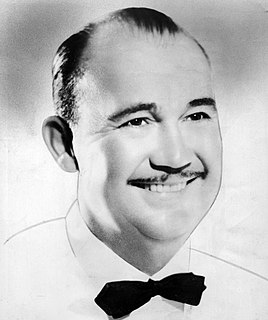
Paul Samuel Whiteman was an American bandleader, composer, orchestral director, and violinist.

Thomas Francis Dorsey Jr. was an American jazz trombonist, composer, conductor and bandleader of the big band era. He was known as the "Sentimental Gentleman of Swing" because of his smooth-toned trombone playing. His theme song was "I'm Getting Sentimental Over You". His technical skill on the trombone gave him renown among other musicians. He was the younger brother of bandleader Jimmy Dorsey. After Dorsey broke with his brother in the mid-1930s, he led an extremely successful band from the late 1930s into the 1950s. He is best remembered for standards such as "Opus One", "Song of India", "Marie", "On Treasure Island", and his biggest hit single, "I'll Never Smile Again".
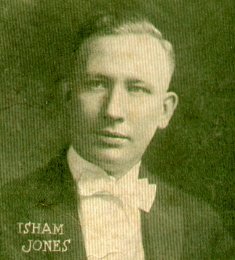
Isham Edgar Jones was an American bandleader, saxophonist, bassist and songwriter.

Neal Paul Hefti was an American jazz trumpeter, composer, and arranger. He wrote music for The Odd Couple movie and TV series and for the Batman TV series.

Harry "Sweets" Edison was an American jazz trumpeter and a member of the Count Basie Orchestra. His greatest impact was as a Hollywood studio musician, whose muted trumpet can be heard backing singers, most notably Frank Sinatra.
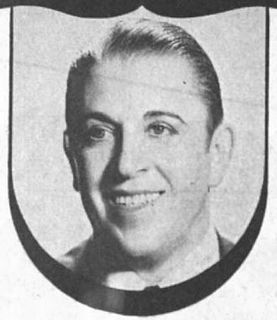
George Edward Olsen Sr. was an American bandleader.
"Blues in the Night" is a popular blues song which has become a pop standard and is generally considered to be part of the Great American Songbook. The music was written by Harold Arlen, the lyrics by Johnny Mercer, for a 1941 film begun with the working title Hot Nocturne, but finally released as Blues in the Night. The song is sung in the film by William Gillespie.
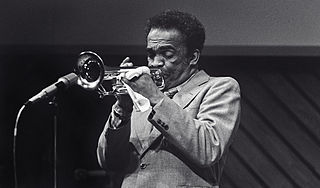
Howard McGhee was one of the first American bebop jazz trumpeters with Dizzy Gillespie, Fats Navarro and Idrees Sulieman. As a multi instrumentalist who played piano and trombone on a few occasions, he was known for his fast fingering and high notes. He had an influence on younger bebop trumpeters such as Fats Navarro.
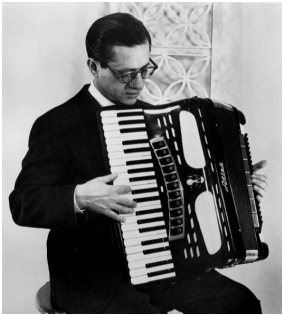
John Serry Sr. was an American concert accordionist, arranger, composer, organist, and educator. He performed on the CBS Radio and Television networks and contributed to Voice of America's cultural diplomacy initiatives during the Golden Age of Radio. He also concertized on the accordion as a member of several orchestras and jazz ensembles for nearly forty years between the 1930s and 1960s.

George Edward Bruns was an American composer of music for film and television. His accolades include four Academy Award nominations, and three Grammy Award nominations. He is mainly known for his compositions for numerous Disney films spanning from the 1950s until the 1970s, among them Sleeping Beauty (1959), One Hundred and One Dalmatians, The Absent-Minded Professor, The Sword in the Stone (1963), The Jungle Book (1967), The Love Bug (1968), The Aristocats (1970), and Robin Hood (1973).

"The Man I Love" is a popular standard in AABA form with music by George Gershwin and lyrics by his brother Ira. Part of the 1924 score for the Gershwin musical comedy Lady, Be Good, the song was deleted from that show and put into the Gershwins' 1927 government satire Strike Up the Band, which closed out-of-town. It was considered for, then rejected from, the 1928 Ziegfeld hit Rosalie.

Herschel "Tex" Evans was an American tenor saxophonist who was a member of the Count Basie Orchestra. He also worked with Lionel Hampton and Buck Clayton. He is also known for starting his cousin Joe McQueen's interest in the saxophone. Joe McQueen, living until 2019 at age 100, may well have been the last surviving person to have known Herschel during his lifetime.
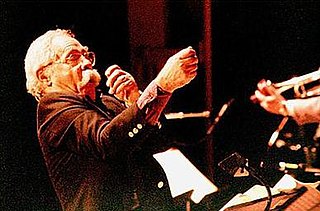
Manny Albam was an American jazz saxophonist, composer, arranger, record producer, and educator.
Darrell Wallace Calker was an American composer and arranger who worked on films and animated cartoons.

Phil Moore was an American jazz pianist, arranger, and bandleader.

Onzy Durrett Matthews, Jr. was an American jazz pianist, singer, arranger and composer as well as a television and movie actor. He is best known for the big band arrangements done for the Lou Rawls albums Black and Blue and Tobacco Road, as well as arrangements for several of Ray Charles' 1960s releases. He had his own big band for many years and recorded numerous tracks for Capitol Records, including two albums released under his own name. He later had a close relationship with the Duke Ellington orchestra, working as a pianist, arranger and conductor through the late 1960s and 1970s.
Joseph P. Lippman was an American composer, arranger, conductor, pianist, and songwriter working in jazz and traditional pop. His musical career was over five decades long, having started at age 19 with the Benny Goodman orchestra in 1934 and writing for television, films, and Broadway in the 1980s. He composed and arranged for Bunny Berigan, Jimmy Dorsey, Sarah Vaughan, Charlie Parker and worked as staff arranger in television for Perry Como and Hollywood Palace.
References
- ↑ 1900 U.S. Census, familysearch.org image file of handwritten census return
- ↑ San Francisco Call, Jan. 16, 1898
- ↑ The Big Band Almanac, Leo Walker
- ↑ Catalog of Copyright Entries, Part 3, Issues 5-6, Library of Congress
- ↑ Eddie Cantor: A Life in Show Business, Gregory Koseluk, page 142
- ↑ Catalog of Copyright Entries: Musical Compositions, Part 3, Library of Congress, 1927
- ↑ Voices of the Jazz Age: Profiles of Eight Vintage Jazzmen, Chip Deffaa, page 63.
- ↑ Los Angeles Times, May 25, 1931
- ↑ Eddie Kilfeather – IMDb
- ↑ The Oregonian, January 14, 1950, page seven, obituary